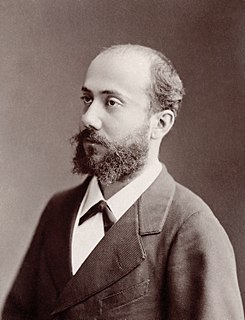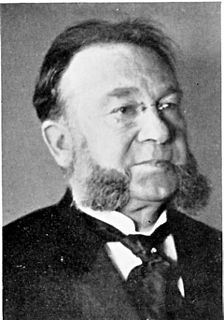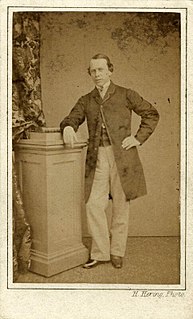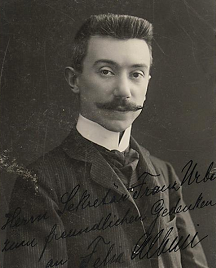Related Research Articles

Franz Adolf Berwald was a Swedish Romantic composer. He made his living as an orthopedist and later as the manager of a saw mill and glass factory, and became more appreciated as a composer after his death than he had been in his lifetime.

Alexandre Clément Léon Joseph Luigini was a French composer and conductor, especially active in the opera house. As a composer, he is now remembered almost solely for his Ballet égyptien.

Karl Klindworth was a German composer, virtuoso pianist, conductor, violinist and music publisher. He was one of Franz Liszt's pupils and later one of his closest disciples and friends, being also on friendly terms with composer Richard Wagner, of whom he was an admirer. He was highly praised by fellow musicians, including Wagner himself and Edward Dannreuther. Among his pupils were Hans von Bülow, Georgy Catoire, and Ethelbert Nevin.

André Charles Prosper Messager was a French composer, organist, pianist and conductor. His compositions include eight ballets and thirty opéras comiques, opérettes and other stage works, among which his ballet Les Deux Pigeons (1886) and opéra comique Véronique (1898) have had lasting success; Les P'tites Michu (1897) and Monsieur Beaucaire (1919) were also popular internationally.

Vittorio Monti was an Italian composer, violinist, mandolinist and conductor. His most famous work is his Csárdás, written around 1904 and played by almost every gypsy orchestra.

Iver Paul Fredrik Holter was a Norwegian composer. He was conductor and music director of the Oslo Philharmonic for a quarter century.

Ignatz Waghalter was a Polish-German composer and conductor.

Alfred Mellon was an English violinist, conductor and composer.

Ludwig Wilhelm Maurer was a German composer, conductor, and violinist born in Potsdam. In 1802, he debuted in Berlin with his first major violin performance. After a brief period of studying French violin style in Mitau (Latvia), Maurer went to Russia at age 17 in 1806, where he would stay for most of his life. For this reason, Maurer is considered both a German and a Russian composer.
John Lodge Ellerton was an English composer of classical music.

James Hamilton Siree Clarke, better known as Hamilton Clarke, was an English conductor, composer and organist. Although Clarke was a prolific composer, he is best remembered as an associate of Arthur Sullivan, for whom he arranged music and compiled overtures for some of the Savoy Operas, including Gilbert and Sullivan's The Mikado.

Edward James Loder was an English composer and conductor. His best remembered work is perhaps the 1855 opera Raymond and Agnes, though his most successful opera during his lifetime was The Night Dancers.
Donald Heins was a Canadian violinist, violist, conductor, organist, composer, and music educator of English birth. He notably founded the first professional orchestra in Ottawa, the Ottawa Symphony Orchestra, in 1902, serving as its director until 1927. He also served in a variety of positions with the Toronto Symphony Orchestra from 1927–1949, including concertmaster, principal violist, and assistant conductor.

Albert Martin Robert Radecke was a German composer and conductor.

Walter Cecil Macfarren was an English pianist, composer and conductor, and a teacher at the Royal Academy of Music.

Lindsay Sloper was an English pianist and composer.

Pierre-Julien Nargeot was a 19th-century French violinist, composer and conductor.

Georges Jacobi was a German violinist, composer and conductor who was musical director of the Alhambra Theatre in London from 1872 to 1898. His best-known work was probably The Black Crook (1872) written with Frederick Clay for the Parisian operetta-star Anna Judic and which ran for 310 performances. Although never achieving the standing of Hervé, or Offenbach or Sullivan, he composed over 100 pieces for ballet and the theatre which were popular at the time.

Rudolf Bial was a German violinist, composer, conductor and theater director.

Srećko (Felix) Albini was a Croatian composer, conductor, and music publisher. He was primarily known for his operettas, some of which were adapted into English and performed in London and New York.
References
- ↑ Lamb, Andrew (2001). "Orellana, I.A. de". In Root, Deane L. (ed.). The New Grove Dictionary of Music and Musicians . Oxford University Press.
- ↑ Jersey, Church of England Births and Baptisms, 1813-1915 for Ignatius Antonio De Orellana St Helier 1855 - 1862 Page 395 of 584
- ↑ Census records from Ancestry.com.
- 1 2 Scores, with information about the composer, from Merton Music. Merton Music catalogue Archived 2014-02-09 at the Wayback Machine Accessed February 2014.
- ↑ "Reviews" . The Musical World. 67 (26): 516. June 30, 1888 – via RIPM.
- ↑ "Reviews" . The Musical World. 70 (47): 938. November 22, 1890 – via RIPM.
- 1 2 3 4 Brief biography of Ignatius de Orellana IMSLP. Accessed February 2014.
- 1 2 Ignatius de Orellana Edition Silvertrust. Accessed February 2014.
- ↑ British Light Music Composers Music Web International. Accessed February 2014.